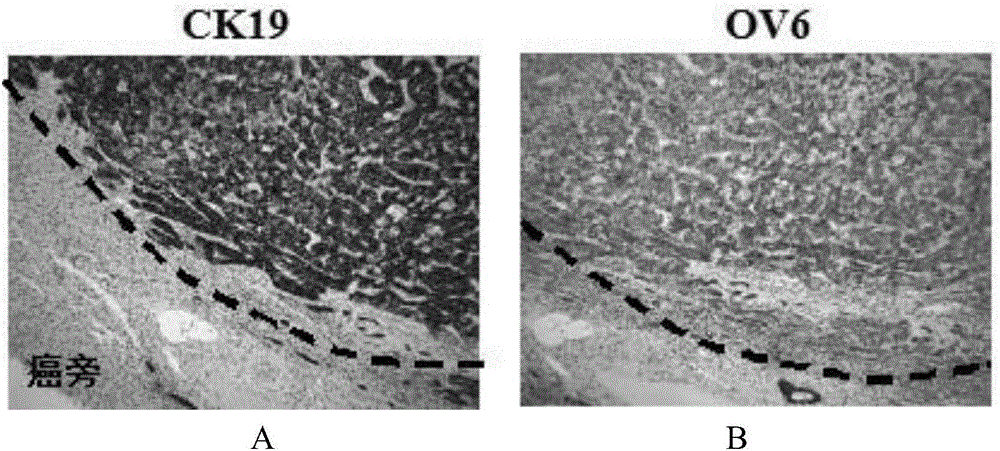Application of ck19 combined with ov6 in preparation of liver cancer molecular typing kit and individualized treatment of liver cancer
A liver cancer, technology for treating liver cancer, applied in the field of medicine
- Summary
- Abstract
- Description
- Claims
- Application Information
AI Technical Summary
Problems solved by technology
Method used
Image
Examples
Embodiment 1
[0059] Example 1: Detection of OV6 Expression in CK19 Positive Liver Cancer Patient Tissues
[0060] By retrieving the pathological information of liver cancer resected by Eastern Hepatobiliary Surgery Hospital, we found that the positive rate of biliary marker CK19 in liver cancer was about 9%. Then randomly select 102 cases of CK19 + HCC was subjected to immunohistochemical staining for the liver precursor cell marker OV6. The OV6 antibody was purchased from R&D Company at a dilution ratio of 1:100. The antigen retrieval condition was high-pressure alkaline retrieval. It was found that about 65% of them were CK19 + OV6 + HCC (see figure 1 ), this part of CK19 + OV6 + HCC may be derived from hepatic precursor cells, suggesting that the combined application of CK19 and OV6 can guide the molecular classification of liver cancer.
Embodiment 2
[0061] Example 2: CK19 + OV6 + HCC and CK19 + OV6 - Prognosis Analysis of HCC Patients
[0062] For the above 102 cases of CK19 + Liver cancer patients were followed up, and the recurrence time of the patients was recorded (recurrence time refers to the date from the date of operation to the date of diagnosis of tumor recurrence). According to the results of immunohistochemistry, CK19 + Liver cancer is classified as CK19 + OV6 + HCC and CK19 + OV6 - HCC, using the Kaplan–Meier method for CK19 + OV6 + HCC and CK19 + OV6 - A comparative analysis of the disease-free survival of HCC patients found that CK19 + OV6 + HCC patients have shorter disease-free survival and poorer prognosis (see figure 2 ). This result suggests that the combined application of CK19 and OV6 can guide the prognosis of liver cancer patients.
Embodiment 3
[0063] Example 3: Effects of the src inhibitor Dasatinib on malignantly transformed hepatic progenitor cells
[0064] We established the malignantly transformed liver precursor cell line WB-TNF (hepatic precursor cell line WB-F344 was stably formed after continuous stimulation with 1ng / ml TNF-α for 20 weeks), and the construction method was as follows:
[0065] 1. Adhesively culture the liver precursor cell line WB-F344 in DMEM containing 0.5% fetal bovine serum, add 1ng / ml TNF-α to the medium;
[0066] 2. Perform trypsinization and passage of cells every two days, and continue to add 1ng / ml TNF-α to the medium after the cells adhere to the wall;
[0067] 3. Cultured for 20 weeks as described in 1 and 2 to establish the malignantly transformed liver precursor cell line WB-TNF.
[0068] It was found that the level of p-src in the malignantly transformed liver precursor cells was significantly increased, and it had an important regulatory effect on the cells.
[0069] Afterwar...
PUM
 Login to View More
Login to View More Abstract
Description
Claims
Application Information
 Login to View More
Login to View More - R&D
- Intellectual Property
- Life Sciences
- Materials
- Tech Scout
- Unparalleled Data Quality
- Higher Quality Content
- 60% Fewer Hallucinations
Browse by: Latest US Patents, China's latest patents, Technical Efficacy Thesaurus, Application Domain, Technology Topic, Popular Technical Reports.
© 2025 PatSnap. All rights reserved.Legal|Privacy policy|Modern Slavery Act Transparency Statement|Sitemap|About US| Contact US: help@patsnap.com



